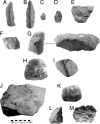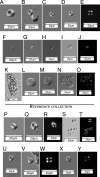4,300-year-old chimpanzee sites and the origins of percussive stone technology
- PMID: 17360606
- PMCID: PMC1805589
- DOI: 10.1073/pnas.0607909104
4,300-year-old chimpanzee sites and the origins of percussive stone technology
Abstract
Archaeological research in the African rainforest reveals unexpected results in the search for the origins of hominoid technology. The ancient Panin sites from Côte d'Ivoire constitute the only evidence of prehistoric ape behavior known to date anywhere in the world. Recent archaeological work has yielded behaviorally modified stones, dated by chronometric means to 4,300 years of age, lodging starch residue suggestive of prehistoric dietary practices by ancient chimpanzees. The "Chimpanzee Stone Age" pre-dates the advent of settled farming villages in this part of the African rainforest and suggests that percussive material culture could have been inherited from an common human-chimpanzee clade, rather than invented by hominins, or have arisen by imitation, or resulted from independent technological convergence.
Conflict of interest statement
The authors declare no conflict of interest.
Figures



References
-
- Savage T, Wyman J. Boston J Nat Hist. 1843;4:362–386.
-
- Boesch C, Boesch H. Folia Primatologica. 1990;54:86–99. - PubMed
-
- Anderson D, Nordheim E, Boesch C, Moermond T. In: Behavioural Diversity in Chimpanzees and Bonobos. Boesch C, Hohmann G, Marchant L, editors. Cambridge, UK: Cambridge Univ Press; 2002. pp. 90–101.
-
- Whitesides G. Primates. 1985;26:91–94.
-
- McGrew W, Baldwin P, Marchant LF, Pruetz JD, Scott SE, Tutin CEG. Palaeoanthropology. 2003;1:1–20.
Publication types
MeSH terms
LinkOut - more resources
Full Text Sources
Research Materials
Miscellaneous

